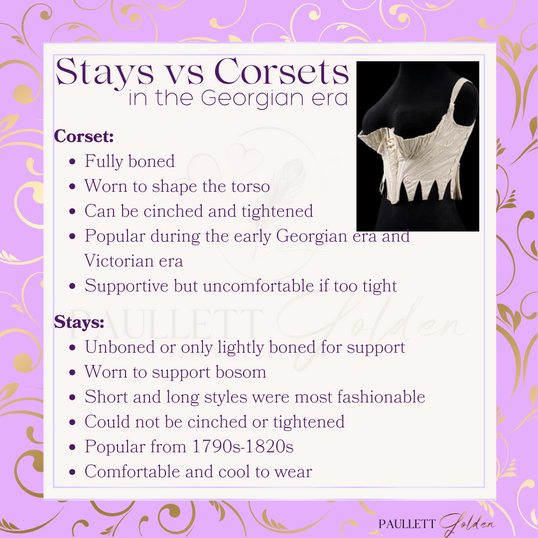Real People. Real Conflict. Real Romance.
Historical Romance
in the style of Jane Austen

Fashion: Stays vs Corsets
A brief comparison of stays and corsets
Let’s open with these fighting words: our heroines of the Regency era would, emphatically, never ever have tightly tugged their corset ribbons as we often see in movies and sometimes, erroneously, read in hist roms of the era.
Why not? Well, to put simply, they didn’t wear corsets!
Corsets were “granny’s” fashion, basically, a fashion accessory of a bygone age, that being earlier in the Georgian era and “totally last century.” Corsets would come back into fashion during the Victorian era, but our late Georgian heroines from the late 1780s on through the Regency era would not have been caught wearing a corset anymore than we would be caught wearing our grandmother’s clothes.
The silhouette of the early Georgian era was all about long waists and wide hips, the emphasis on wide hips and small waists. Little to no emphasis was placed on the bosom, so the corsets were more inclined to squash "the ladies" than to boost them, all to draw attention to the long and slender torso and those enticing birthing hips (brought to you by panniers).
The silhouette of the late Georgian era, from about 1788-1820ish, was more cylindrical and natural, no more cinched waists. The waist line was brought to just below the bosom to create a straight torso and loose skirt, thus hiding any pudges and bringing more attention to the bosom itself. Bye bye panniers, and thus bye bye wide hips. This was an age of form-flattering comforts, as the pudgy bits were well hidden beneath loose gowns, nothing was cinched tight, and even the flattest chests got a nice boost.
The key lies in the amount of boning and placement of boning. The corset is fully boned to guide (aka force) the figure into the desired shape. Stays either have no boning whatsoever or subtle boning only where there needs to be support added, no shaping required, ie a natural look.
There were quite a few different types of stays, from transitional stays to half stays, but the most popular tended to be what we call short stays and long stays, depending on a lady's needs. Their difference is literally in the name. Short stays are similar to today’s sports bra in style. Long stays, however, extend past the naval. It’s the “look” of the long stays that often confuse them for corsets.
There was no way whatsoever to tighten stays, be they short or long. These were loose garments fitted over (yes, over) the chemise to keep the jiggly bits from jiggling, nothing more, nothing less.
Our Regency era heroines would have worn stays, and thus no tight cinching, not shortness of breath, no pinching or creaking of boning, just super comfortable, sweat-wicking linen.
Something of note that’s beyond the scope of this brief tid bit is that corsets were still worn during this era, just not by ladies of fashion. Some of the older sticklers would have been hard-pressed to leave their old fashions in the past, but more specifically, the servants often worse corsets for support. They did not wear corsets to emphasize their waist, nor did they tighten the laces to the point of compression, rather corsets offered the needed support to keep trucking through manual labour (like a back brace).
Two absolute must reads come from Ilse Gregor and The Dreamstress:
Ilse Gregor, “What Corset to Wear with a Regency Gown”: https://www.ilsegregoorcostumes.com/the-stays-or-corsets-of-the-regency-era/
The Dreamstress, “A Quick Guide to Corset & Stay Styles from 1750 to 1850”: https://thedreamstress.com/2017/04/a-quick-guide-to-corset-stay-styles-from-1750-to-1850/
If you prefer videos, check out this fun one from Abby Cox, “A Dress Historian Explains the Difference between Corsets and Stays”: https://youtu.be/j8tRK3gn-NA?si=HFpvkmYYAChRoXdx
Banner image courtesy of Victoria & Albert Museum: https://collections.vam.ac.uk/item/O138889/stays-unknown/ (check out additional images of this pair of transitional stays by clicking the V&A Museum's link)
